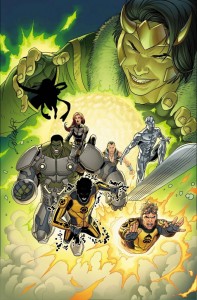 All-New Marvel Now! Point One #1 — Creators: Various
All-New Marvel Now! Point One #1 — Creators: Various
This is a series of eight-page stories involving five new Marvel launches — Silver Surfer, Ms. Marvel, The Invaders, Black Widow and Avengers World — meant to showcase those books’ creative teams and tempt readers into buying the comics; the stories are all woven together with a quest by Loki, who’s also headlining a new title: Loki, Agent of Asgard. Points here for making each episode a brand-new story, and not just a reprint of pages from the various first issues — but points off for charging readers $6 for the whole thing — yes, it’s new material, but it’s a promo book, and the high cover price works against its purpose; you wonder if the Marvel powers-that-be have ever heard of the term “loss leader.”
So, how are the stories? The best is the Silver Surfer, by Dan Slott and Michael Allred: I mean, c’mon, Allred on the Silver Surfer is just perfect, and Slott provides the right combination of tongue-in-cheek absurdity, cosmic spectacle and action to make it all work; I’m looking forward to this one already. Tied for second are the Black Widow, by Nathan Edmondson and Phil Noto, and Ms. Marvel, by G. Willow Wilson and Adrian Alphona; the Widow is working as a spy-contractor-for-hire, while Ms. Marvel is a New Jersey girl, a teenager who’s also from an Islamic family and has just gotten Plastic-Man-like powers and is trying to figure out what to do with them (so we’re in early Spider-Man territory, crossed with “All-American Muslim”). Both benefit from nice-looking art and great coloring work, and do their jobs of making you want to read the new comics featuring these characters. Next is the Avengers World entry, by Nick Spencer and Rags Morales, in which Captain America and Maria Hill (the director of SHIELD), team up their organizations for proactive globe-trotting assignments, like Secret Avengers but without all the black-ops mind-control baggage that title has carried. It’s OK, and the Morales art is pleasant to look at, but is otherwise typical Avengers stuff. The Invaders, by James Robinson and Steve Pugh, is the least successful; first, it’s the Invaders, and second it’s a complicated origin involving the Kree Supreme Intelligence sending a badass blue woman after some cosmic WWII-era macguffin that was split into three parts, one each now held by the original Human Torch, the Sub-Mariner and Bucky, the Winter Soldier. Whatever…. That leaves the Loki installments, by Al Ewing and Lee Garbett, which manage to do a good job of continuing the now-young-adult trickster god’s character arc from Young Avengers and making him a sort-of-good, sort-of-not agent undertaking missions for the All-Mother triad who are the current rulers of Asgard; I’m likely to read that new book, too.
Black Widow #1 — Writer: Nathan Edmondson; Art: Phil Noto
Other creators could take some lessons from the first issue of this book: it doesn’t kick off a dense multi-part saga, and it doesn’t weigh down readers with origin details, retcons or other superfluous information. Instead, it presents Natasha doing what she does best — being a tough-as-nails, resourceful freelance spy — in two different encounters, while giving just enough information to explain what she’s doing, and why we should care about it. The Noto art is pretty (he’s his own colorist, and some of the shades and painterly effects here are just beautiful), but delivers action sharply and clearly, and when the issue’s over there are no cliffhangers or loose ends, but we want to keep reading about this person. As I said: other creators should be taking notes.
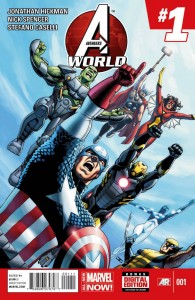 Avengers World #1 — Writers: Jonathan Hickman and Nick Spencer; Art: Stafano Caselli
Avengers World #1 — Writers: Jonathan Hickman and Nick Spencer; Art: Stafano Caselli
So, SHIELD and the Avengers have decided to partner up, to better deal with all the crises out there, and we begin with a bunch of different characters being sent on different missions, but it turns out they’re actually all connected, revealing a Big Bad that I won’t spoil, except to see that it’s something that Marvel has been building up for a couple of years now. It’s OK, but, given the sprawling stories taking place in the other Avengers titles at the moment, did we really need yet another complicated, pumped-up, who-knows-how-long epic to entertain us? Can’t someone just give Warren Ellis a bucket of money and let him write those perfect, 20-page Secret Avengers done-in-one issues for the next ten years instead?
All-New X-Factor #1 — Writer: Peter David; Art: Carmine di  Giandomenico
Giandomenico
Same title and writer, but different artist and a different set of circumstances and characters, as David brought the previous X-Factor series to a logical ending, and gave most of the featured players a well-deserved send-off, late last year. Here, there’s a mysterious corporation who wants to do good, and has bought rights to the team name; they’ve recruited Polaris, who recruits Gambit, and then Quicksilver shows up, and I suppose we’ll see who else joins the group as we roll along. David’s writing is comfortable as an old sweater — he has a glib knack for dialogue and humor, a firm grasp of character, and a facility for plotting that keeps events clicking along nicely, and readers on their toes. The art is… OK, I guess, but doesn’t call much attention to itself; there aren’t any “Oh, wow!” moments or startling effects (the one splash page is forgettable), but it’s not bad, and the action is clear. With someone as story- and character-oriented as David providing the story, that’s more than enough.
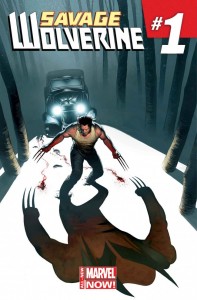 Savage Wolverine #14.Now — Writer/Artist: Richard Isanove
Savage Wolverine #14.Now — Writer/Artist: Richard Isanove
I’m not sure why the cover copy says that Isanove is the “master of noir”; he’s probably best-known as a colorist (he worked on the original Wolverine: Origin, so he has some history with Logan), although he’s done art for some of the Dark Tower comics; here; he’s both writing and penciling a multi-part tale set in 1930s Canada and the Northern US, in the waning days of Prohibition. It is noirish, true enough, all tommy guns and tough-guy patter and mobsters and kidnapped daughters, and the art and coloring are suitably moody. The “14.Now” numbering just seems to be an excuse to put a prominent “#1” on the cover, although presumably this will be a four- or five-part arc, just like all the other ones in this title so far; if you’re a Wolverine fan, you could do worse.
Young Avengers #15 — Writer: Kieron Gillen; Art: Becky Cloonan and  Jordie Bellaire; Ming Doyle and Maris Wicks; Joe Quinones and Maris Wicks; Jamie McKelvie and Matthew Wilson
Jordie Bellaire; Ming Doyle and Maris Wicks; Joe Quinones and Maris Wicks; Jamie McKelvie and Matthew Wilson
The title and story end together, with most questions answered, the group largely intact, and everyone getting a chance for a bow (the poignant and perfect last shot, of course, belonging to Loki). It’s hard to believe that the next incarnation of this book will be as imaginative, as fun, or as casually dead-on about its young adults and their relationships as this one (or as good about making subtle points about their welcome, democratic acceptance concerning sex or sexuality, all in a PG setting, either), and while all the guest artists are good, it’s fitting that the ending should come back to McKelvie, whose crisp, expressive human versions of these characters should be the definitive one for years to come. Now, I’ve gotta find time to reread the whole thing, and see if it holds together as well as I think it does….
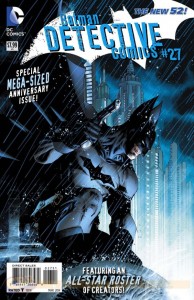 Detective #27 — Creators: Various
Detective #27 — Creators: Various
This is a celebration of Batman’s first appearance in the original Detective #27, 75 years ago in May, 1939, and other than the (literally) butt-ugly Frank Miller alternate cover, it does a fine job — first, the book’s regular team, John Layman and Jason Fabok, contribute the first chapter of the next bat-crossover, “Gothtopia,” involving a too-perfect Gotham City and the cast’s gradual realization that there’s something wrong about it. The best of the additional stories include Brad Meltzer and Bryan Hitch’s “The Case of the Chemical 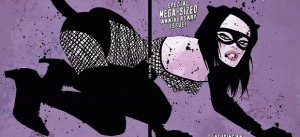 Syndicate,” a re-imagination of one of the Dark Knight’s first cases, and the inevitable Neal Adams piece (over a story written by Gregg Hurwitz, not Adams himself, fortunately). There’s also a Scott Snyder/Sean Murphy tale, ones by Mike Barr/Guillem March and Peter Tomasi/Ian Bertram, and a final contribution from the ubiquitous Francesco Francavilla; throw in pin-ups by, among others, Michael Allred, Jock, Kelly Jones and Graham Nolan, and this earns its $7.99 cover price, and shows that there’s still a lot of life left in the World’s Greatest Detective.
Syndicate,” a re-imagination of one of the Dark Knight’s first cases, and the inevitable Neal Adams piece (over a story written by Gregg Hurwitz, not Adams himself, fortunately). There’s also a Scott Snyder/Sean Murphy tale, ones by Mike Barr/Guillem March and Peter Tomasi/Ian Bertram, and a final contribution from the ubiquitous Francesco Francavilla; throw in pin-ups by, among others, Michael Allred, Jock, Kelly Jones and Graham Nolan, and this earns its $7.99 cover price, and shows that there’s still a lot of life left in the World’s Greatest Detective.
The Vampire Diaries #1 — Writer: Colleen Doran; Art: Tony Shasteen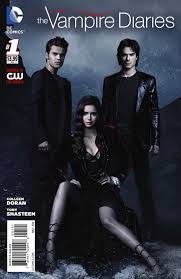
Doran, usually an artist, has always been a writer too, and here she contributes a nasty, well-plotted story spanning 150 years in Mystic Falls, involving Damon, Stefan, and a witch named Julian. It’s all done in one issue, too, so it’s useful souvenir for fans of the series — especially the version with the photo cover.
 L’il Vampi One-Shot — Writer: Eric Trautmann; Art: Agnes Grabowska
L’il Vampi One-Shot — Writer: Eric Trautmann; Art: Agnes Grabowska
Tiny Titans has a lot to answer for — Dynamite’s been doing a series of these little-kid-centric versions of their book, starting with Evil Ernie and including Red Sonya and Battlestar Galactica (with the Art Baltazar covers driving the point home even further), and now it’s Vampi’s turn. Grtabowska’s interior art really is adorable, more detailed and mangaesque than Baltazar’s, but of the same sensibility, and the story’s good at creating a whole self-contained town and cast of characters for L’il Vampi; this could totally be a cartoon series, and a good one.
Iron Man #20 — Writer: Kieron Gillen; Pencils: Joe Bennett; Inks: Scott 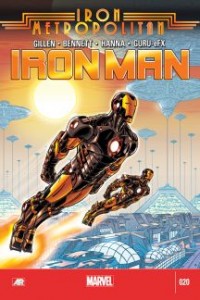 Hanna
Hanna
Turns out, while the Mandarin might be dead, his rings have been busy, going all Green Lantern-y and finding individual wielders, and now they’re striking back at Tony Stark’s (and his newfound brother, Arno’s) high-tech future-city plans. This will all be OK if it’s quick; I don’t think we need another year-long Mandarin story so soon after the one Fraction did to wrap up his run on the title a year or two ago, and shorter arcs, like four or five issues, play more to Gillen’s strengths. Bennett gets a couple of chances to show what he can do here, and delivers; there’s a two-page spread near the beginning that offers some energy and classic posing, while a centerfold splash shows off his ability to draw the various Iron Man armors, and some later panels give him a chance to do some space scenes well, too.
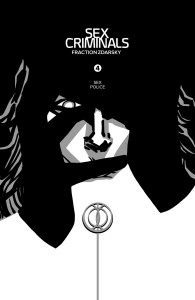 Sex Criminals #4 — Writer: Matt Fraction; Art: Chip Zdarsky
Sex Criminals #4 — Writer: Matt Fraction; Art: Chip Zdarsky
Still good, although not too much happens in this issue; it’s mostly about using what Suze calls The Quiet to play Robin Hood (and get off), and finding out a little more about the mysterious other people who’ve showed up to spoil those plans; it’ll work better as a bridge chapter in the trade versions than a stand-alone. We do get the letters pages, which are almost worth the cover price by themselves; it’s no accident that three of the most successful writers of the last decade — Brian Bendis, Robert Kirkman and Matt Fraction — have all been masters of using their comics’ letters pages to help cobble their readers together into communities of committed, hardcore fans.
Minimum Wage #1 — Creator: Bob Fingerman
This is a revival of the well-regarded ’90s series about Rob, a scrabbling sort-of-hipster cartoonist in New York City, his girlfriend Sylvia and their extended circles of family and friends. That original series ended with the couple’s marriage, but here we are about three years later, in the year 2000, and Rob is already divorced and single again, in his mid-20s with Sylvia nowhere in sight, and trying to figure out what to do next. That’s bad for him but good for the story, and the turn-of-the-century setting, where a lot of artists were struggling with the shrinking magazine and newspaper markets, and experimenting with the still-new Internet (not that they’re not still doing all that today, too…), should be fodder for some interesting plots.
 Afterlife With Archie #3 — Writer: Roberto Aguirre-Sacasa; Art: Francesco Francavilla
Afterlife With Archie #3 — Writer: Roberto Aguirre-Sacasa; Art: Francesco Francavilla
Not that much happens here, either; two of the minor cast members become zombies, but they’re dealt with quickly, and there’s a lot of taking stock, surveying the situation and trying to figure out who’s safe, who isn’t and what to do next. There’s no single “Holy crap!” moment like in the first two issues, and now that the novelty’s started to wear off they might be harder to come by. No reason to give up yet — there’s still a lot to mine here — but they’ve been calling this an “ongoing series,” and there’s a question of just how long they’ll be able to string out this story until the characters become too far from standard-Archie and the conceit snaps.



